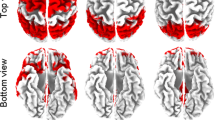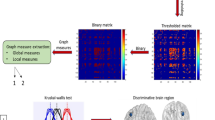Abstract
Hyperventilation (HV) is a voluntary activity that causes changes in the neuronal firing characteristics noticeable in the electroencephalogram (EEG) signals. HV-related changes have been scribed to modulation of pO2/pCO2 blood contents. Therefore, an HV test is routinely used for highlighting brain abnormalities including those depending to neurobiological mechanisms at the basis of neurodegenerative disorders. The main aim of the present paper is to study the effectiveness of HV test in modifying the functional connectivity from the EEG signals that can be typical of a prodromal state of Alzheimer’s disease (AD), the Mild Cognitive Impairment prodromal to Alzheimer condition. MCI subjects and a group of age-matched healthy elderly (Ctrl) were enrolled and subjected to EEG recording during HV, eyes-closed (EC), and eyes-open (EO) conditions. Since the cognitive decline in MCI seems to be a progressive disconnection syndrome, the approach we used in the present study is the graph theory, which allows to describe brain networks with a series of different parameters. Small world (SW), modularity (M), and global efficiency (GE) indexes were computed among the EC, EO, and HV conditions comparing the MCI group to the Ctrl one. All the three graph parameters, computed in the typical EEG frequency bands, showed significant changes among the three conditions, and more interestingly, a significant difference in the GE values between the MCI group and the Ctrl one was obtained, suggesting that the combination of HV test and graph theory parameters should be a powerful tool for the detection of possible cerebral dysfunction and alteration.




Similar content being viewed by others
Data availability
The data that support the findings of this study are available on request from the corresponding author.
References
Van der Worp HB, Kraaier V, Wieneke GH, Van Huffelen AC. Quantitative EEG during progressive hypocarbia and hypoxia. Hyperventilation-induced EEG changes reconsidered. Electroencephalogr Clin Neurophysiol. 1991;79(5):335–41. https://doi.org/10.1016/0013-4694(91)90197-c.
Mazzucchi E, et al. Hyperventilation in patients with focal epilepsy: electromagnetic tomography, functional connectivity and graph theory - a possible tool in epilepsy diagnosis? J Clin Neurophysiol. 2017;34(1):92–9. https://doi.org/10.1097/WNP.0000000000000329.
Mäkiranta MJ, et al. BOLD-contrast functional MRI signal changes related to intermittent rhythmic delta activity in EEG during voluntary hyperventilation-simultaneous EEG and fMRI study. Neuroimage. 2004;22(1):222–31. https://doi.org/10.1016/j.neuroimage.2004.01.004.
Khachidze I, Gugushvili M, Advadze M. EEG characteristics to hyperventilation by age and sex in patients with various neurological disorders. Front Neurol. 2021;12:727297. https://doi.org/10.3389/fneur.2021.727297.
Plouin P, Kaminska A, Moutard ML, Soufflet C. Developmental aspects of normal EEG. Handb Clin Neurol. 2013;111:79–85. https://doi.org/10.1016/B978-0-444-52891-9.00007-5.
Kennealy JA, Penovich PE, Moore-Nease SE. EEG and spectral analysis in acute hyperventilation. Electroencephalogr Clin Neurophysiol. 1986;63(2):98–106. https://doi.org/10.1016/0013-4694(86)90002-7.
Brian JE. Carbon dioxide and the cerebral circulation. Anesthesiology. 1998;88(5):1365–86. https://doi.org/10.1097/00000542-199805000-00029.
Petersen RC, et al. Apolipoprotein E status as a predictor of the development of Alzheimer's disease in memory-impaired individuals. JAMA. 1995;273(16):1274–8.
Petersen RC, et al. Current concepts in mild cognitive impairment. Arch Neurol. 2001;58:1985–92. https://doi.org/10.1001/archneur.58.12.1985.
Scheltens P, Fox N, Barkhof F, De Carli C. Structural magnetic resonance imaging in the practical assessment of dementia: beyond exclusion. Lancet Neurol. 2002;1(1):13–21. https://doi.org/10.1016/s1474-4422(02)00002-9.
Ponomareva NV, Korovaitseva GI, Rogaev EI. EEG alterations in non-demented individuals related to apolipoprotein E genotype and to risk of Alzheimer disease. Neurobiol Aging. 2008;29(6):819–27. https://doi.org/10.1016/j.neurobiolaging.2006.12.019.
Vecchio F, Miraglia F, Bramanti P, Rossini PM. Human brain networks in physiological aging: a graph theoretical analysis of cortical connectivity from EEG data. J Alzheimers Dis. 2014;41(4):1239–49. https://doi.org/10.3233/JAD-140090.
Rossini PM, Di Iorio R, Granata G, Miraglia F, Vecchio F. From mild cognitive impairment to Alzheimer's disease: a new perspective in the "Land" of human brain reactivity and connectivity. J Alzheimers Dis. 2016;53(4):1389–93. https://doi.org/10.3233/jad-160482.
Miraglia F, et al. Brain connectivity and graph theory analysis in Alzheimer's and Parkinson's disease: the contribution of electrophysiological techniques. Brain Sci. 2022;12(3):402. https://doi.org/10.3390/brainsci12030402.
Başar E, Schürmann M. Toward new theories of brain function and brain dynamics. Int J Psychophysiol. 2001;39(2-3):87–9. https://doi.org/10.1016/s0167-8760(00)00134-3.
Miller EK, Wilson MA. All my circuits: using multiple electrodes to understand functioning neural networks. Neuron. 2008;60(3):483–8. https://doi.org/10.1016/j.neuron.2008.10.033.
Friston KJ, Büchel C. CHAPTER 37 - Functional connectivity: eigenimages and multivariate analyses. In: Friston K, Ashburner J, Kiebel S, Nichols T, Penny W, editors. Statistical parametric mapping: Academic Press; 2007. p. 492–507. https://doi.org/10.1016/B978-012372560-8/50037-1.
Vecchio F, Miraglia F, Maria RP. Connectome: graph theory application in functional brain network architecture. Clin Neurophysiol Pract. 2017;2:206–13. https://doi.org/10.1016/j.cnp.2017.09.003.
Vecchio F, et al. Graph theory on brain cortical sources in Parkinson's disease: the analysis of 'Small World' organization from EEG. Sensors (Basel). 2021;21(21):31. https://doi.org/10.3390/s21217266.
Winblad B, et al. Mild cognitive impairment--beyond controversies, towards a consensus: report of the International Working Group on Mild Cognitive Impairment. J Intern Med. 2004;256(3):240–6. https://doi.org/10.1111/j.1365-2796.2004.01380.x.
Petersen RC. Clinical practice. Mild cognitive impairment. N Engl J Med. 2011;364(23):2227–34. https://doi.org/10.1056/NEJMcp0910237.
McKhann G, Drachman D, Folstein M, Katzman R, Price D, Stadlan EM. Clinical diagnosis of Alzheimer's disease: report of the NINCDS-ADRDA Work Group under the auspices of Department of Health and Human Services Task Force on Alzheimer's Disease. Neurology. 1984;34(7):939–44. https://doi.org/10.1212/wnl.34.7.939.
Miraglia F, et al. Assessing the dependence of the number of EEG channels in the brain networks' modulations. Brain Res Bull. 2021;167:33–6. https://doi.org/10.1016/j.brainresbull.2020.11.014.
Pappalettera C, Miraglia F, Cotelli M, Rossini PM, Vecchio F. Analysis of complexity in the EEG activity of Parkinson's disease patients by means of approximate entropy. Geroscience. 2022;44(3):1599–607. https://doi.org/10.1007/s11357-022-00552-0.
Vecchio F, Miraglia F, Judica E, Cotelli M, Alù F, Rossini PM. Human brain networks: a graph theoretical analysis of cortical connectivity normative database from EEG data in healthy elderly subjects. Geroscience. 2020;42(2):575–84. https://doi.org/10.1007/s11357-020-00176-2.
Vecchio F, Miraglia F, Alù F, Menna M, Judica E, Cotelli M, Rossini PM. Classification of Alzheimer's disease with respect to physiological aging with innovative EEG biomarkers in a machine learning implementation. J Alzheimers Dis. 2020;75(4):1253–61. https://doi.org/10.3233/JAD-200171.
Pappalettera C, Cacciotti A, Nucci L, Miraglia F, Rossini PM, Vecchio F. Approximate entropy analysis across electroencephalographic rhythmic frequency bands during physiological aging of human brain. Geroscience. 2022. https://doi.org/10.1007/s11357-022-00710-4.
Hoffmann S, Falkenstein M. The correction of eye blink artefacts in the EEG: a comparison of two prominent methods. PLoS One. 2008;3(8):e3004. https://doi.org/10.1371/journal.pone.0003004.
Iriarte J, et al. Independent component analysis as a tool to eliminate artifacts in EEG: A quantitative study. J Clin Neurophysiol. 2003;20(4):249–57. https://doi.org/10.1097/00004691-200307000-00004.
Jung TP, et al. Removing electroencephalographic artifacts by blind source separation. Psychophysiology. 2000;37(2):163–78.
Vecchio F, Nucci L, Pappalettera C, Miraglia F, Iacoviello D, Rossini PM. Time-frequency analysis of brain activity in response to directional and non-directional visual stimuli: an event related spectral perturbations (ERSP) study. J Neural Eng. 2022;19(6). https://doi.org/10.1088/1741-2552/ac9c96.
Mulert C, et al. Integration of fMRI and simultaneous EEG: towards a comprehensive understanding of localization and time-course of brain activity in target detection. Neuroimage. 2004;22(1):83–94. https://doi.org/10.1016/j.neuroimage.2003.10.051.
Vitacco D, Brandeis D, Pascual-Marqui R, Martin E. Correspondence of event-related potential tomography and functional magnetic resonance imaging during language processing. Hum Brain Mapp. 2002;17(1):4–12. https://doi.org/10.1002/hbm.10038.
Worrell GA, et al. Localization of the epileptic focus by low-resolution electromagnetic tomography in patients with a lesion demonstrated by MRI. Brain Topogr. 2000;12(4):273–82.
Dierks T, et al. Spatial pattern of cerebral glucose metabolism (PET) correlates with localization of intracerebral EEG-generators in Alzheimer's disease. Clin Neurophysiol. 2000;111:1817–24.
Pizzagalli DA, et al. Functional but not structural subgenual prefrontal cortex abnormalities in melancholia. Mol Psychiatry. 2004;9(4):393–405. https://doi.org/10.1038/sj.mp.4001469.
Zumsteg D, Wennberg RA, Treyer V, Buck A, Wieser HG. H2(15) O or 13NH3 PET and electromagnetic tomography (LORETA) during partial status epilepticus. Neurology. 2005;65(10):1657–60. https://doi.org/10.1212/01.wnl.0000184516.32369.1a.
Vecchio F, et al. Human brain networks in physiological and pathological aging: reproducibility of electroencephalogram graph theoretical analysis in cortical connectivity. Brain Connect. 2022;12(1):41–51. https://doi.org/10.1089/brain.2020.0824.
Kubicki S, Herrmann WM, Fichte K, Freund G. Reflections on the topics: EEG frequency bands and regulation of vigilance. Pharmakopsychiatr Neuropsychopharmakol. 1979;12(2):237–45. https://doi.org/10.1055/s-0028-1094615.
Pascual-Marqui RD. Discrete, 3D distributed, linear imaging methods of electric neuronal activity. Part 1: exact, zero error localization. arXiv:0710.3341 [math-ph]. 2007; http://arxiv.org/pdf/0710.3341.
Pascual-Marqui RD, et al. Assessing interactions in the brain with exact low-resolution electromagnetic tomography. Philos Trans A Math Phys Eng Sci. 1952;2011(369):3768–84. https://doi.org/10.1098/rsta.2011.0081.
Watts DJ, Strogatz SH. Collective dynamics of 'small-world' networks. Nature. 1998;393(6684):440–2. https://doi.org/10.1038/30918.
Vecchio F, Pappalettera C, Miraglia F, Deinite G, Manenti R, Judica E, Caliandro P, Rossini PM. Prognostic role of hemispherical functional connectivity in stroke: a study via graph theory versus coherence of electroencephalography rhythms. Stroke. 2022. https://doi.org/10.1161/STROKEAHA.122.040747.
Rubinov M, Sporns O. Complex network measures of brain connectivity: uses and interpretations. Neuroimage. 2010;52(3):1059–69. https://doi.org/10.1016/j.neuroimage.2009.10.003.
Vecchio F, et al. Sustainable method for Alzheimer dementia prediction in mild cognitive impairment: electroencephalographic connectivity and graph theory combined with apolipoprotein E. Ann Neurol. 2018;84(2):302–14. https://doi.org/10.1002/ana.25289.
Miraglia F, Vecchio F, Rossini PM. Brain electroencephalographic segregation as a biomarker of learning. Neural Netw. 2018;106:168–74. https://doi.org/10.1016/j.neunet.2018.07.005.
Latora V, Marchiori M. Efficient behavior of small-world networks. Phys Rev Lett. 2001;87(19):198701. https://doi.org/10.1103/PhysRevLett.87.198701.
Bassett DS, Bullmore E. Small-world brain networks. Neuroscientist. 2006;12(6):512–23. https://doi.org/10.1177/1073858406293182.
Siddiqui SR, Zafar A, Khan FS, Shaheen M. Effect of hyperventilation on electroencephalographic activity. J Pak Med Assoc. 2011;61(9):850–2.
Hallett M, et al. Human brain connectivity: clinical applications for clinical neurophysiology. Clin Neurophysiol. 2020;131(7):1621–51. https://doi.org/10.1016/j.clinph.2020.03.031.
Tan B, Kong X, Yang P, Jin Z, Li L. The difference of brain functional connectivity between eyes-closed and eyes-open using graph theoretical analysis. Comput Math Methods Med. 2013;2013:976365. https://doi.org/10.1155/2013/976365.
Miraglia F, Vecchio F, Bramanti P, Rossini PM. EEG characteristics in "eyes-open" versus "eyes-closed" conditions: small-world network architecture in healthy aging and age-related brain degeneration. Clin Neurophysiol. 2016;127(2):1261–8. https://doi.org/10.1016/j.clinph.2015.07.040.
Wang Y, et al. Open eyes increase neural oscillation and enhance effective brain connectivity of the default mode network: resting-state electroencephalogram research. Front Neurosci. 2022;16:861247. https://doi.org/10.3389/fnins.2022.861247.
Bullmore E, Sporns O. The economy of brain network organization. Nat Rev Neurosci. 2012;13(5):336–49. https://doi.org/10.1038/nrn3214.
Wei C, et al. A comparative study of structural and metabolic brain networks in patients with mild cognitive impairment. Front Aging Neurosci. 2021;13:774607. https://doi.org/10.3389/fnagi.2021.774607.
Youssef N, et al. Functional brain networks in mild cognitive impairment based on resting electroencephalography signals. Front Comput Neurosci. 2021;15:698386. https://doi.org/10.3389/fncom.2021.698386.
Vecchio F, et al. Cortical brain connectivity evaluated by graph theory in dementia: A correlation study between functional and structural data. J Alzheimers Dis. 2015;45(3):745–56. https://doi.org/10.3233/JAD-142484.
Franciotti R, et al. Cortical network topology in prodromal and mild dementia due to Alzheimer's disease: Graph theory applied to resting state EEG. Brain Topogr. 2019;32(1):127–41. https://doi.org/10.1007/s10548-018-0674-3.
Stanley ML, Simpson SL, Dagenbach D, Lyday RG, Burdette JH, Laurienti PJ. Changes in brain network efficiency and working memory performance in aging. PLoS One. 2015;10(4):e0123950. https://doi.org/10.1371/journal.pone.0123950.
Mazzucchi E, et al. 6. Hyperventilation increases brain connectivity in healthy subjects and in focal cryptogenic epileptic patients. Clin Neurophysiol. 2015;126(1):e2. https://doi.org/10.1016/j.clinph.2014.10.025.
Funding
This work was partially supported by the Italian Ministry of Health for Institutional Research (Ricerca corrente), for the project “Prediction of conversion from Mild Cognitive Impairment to Alzheimer’s disease based on TMS-EEG biomarkers” (GR-2016-02361802) and by Toto Holding.
Author information
Authors and Affiliations
Corresponding author
Ethics declarations
Authors’ disclosure statements
None of the authors have potential conflicts of interest to be disclosed.
Additional information
Publisher’s note
Springer Nature remains neutral with regard to jurisdictional claims in published maps and institutional affiliations.
About this article
Cite this article
Miraglia, F., Pappalettera, C., Guglielmi, V. et al. The combination of hyperventilation test and graph theory parameters to characterize EEG changes in mild cognitive impairment (MCI) condition. GeroScience 45, 1857–1867 (2023). https://doi.org/10.1007/s11357-023-00733-5
Received:
Accepted:
Published:
Issue Date:
DOI: https://doi.org/10.1007/s11357-023-00733-5




